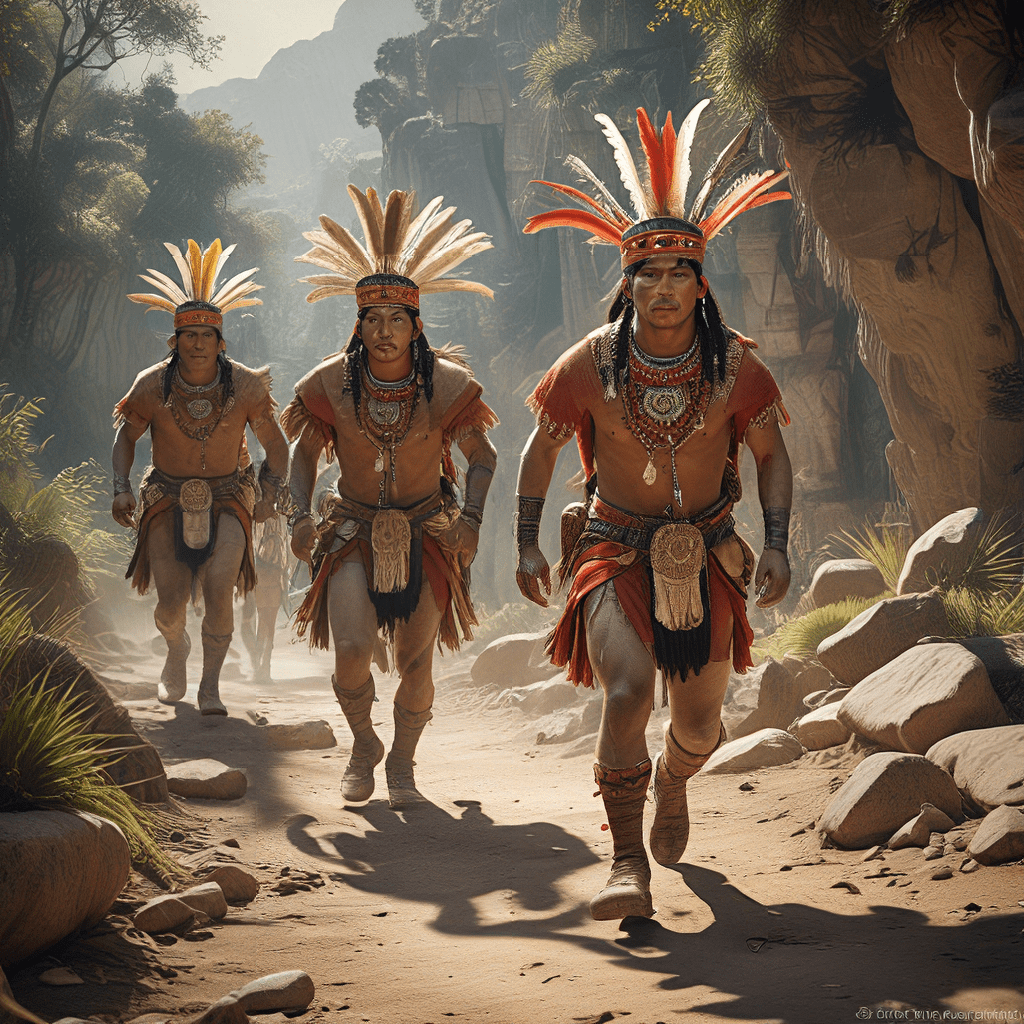The Mythical Image of the Chasqui
The Chasqui, a legendary runner from the Inca Empire, is a captivating figure shrouded in myth and folklore. Their image is often associated with incredible speed and endurance, effortlessly traversing the vast Andes Mountains, relaying crucial messages across the Inca Empire. This image has been popularized in books, movies, and television, solidifying the Chasqui's position as the epitome of communication in the Inca Empire.
Their iconic image often depicts them running tirelessly, with a small pouch tied to their waist, containing important messages or decrees from the Inca Emperor. Imagine a world without modern communication, where messages were physically carried over hundreds of miles, traversing treacherous landscapes and reaching their destination with incredible speed. This is the image that has captured the imagination of many, cementing the Chasqui's place as a powerful symbol of the Inca Empire's efficiency and logistical prowess.
Speed and Endurance: The Legendary Chasqui Runner
The tales of the Chasqui often portray them as superhuman, with the ability to cover vast distances in record time. Descriptions of their endurance are equally impressive, with accounts of runners able to cover incredible distances without rest or sustenance. Some myths even suggest that the Chasqui could run for days on end, relying on a unique system of relays to ensure swift and reliable message delivery.
These tales often portray the Chasqui as an elite, carefully selected group of individuals, trained from a young age to excel in speed, endurance, and agility. They are depicted as physically formidable, with lithe frames and powerful legs, enabling them to navigate the challenging terrain of the Andes with ease.
The Role of the Chasqui in Incan Society
The Chasqui played a vital role in the functioning of the Inca Empire, serving as the backbone of their communication system. The Empire relied on the Chasqui to relay messages across vast distances, facilitating trade, administration, and the dissemination of vital information, such as the Emperor's decrees, army movements, and natural disasters. The success of the Inca Empire in maintaining its vast territory was directly tied to the efficiency and reliability of its communication system.
They were trained and organized into a complex network, with designated routes and checkpoints strategically placed throughout the Empire. This system allowed for the rapid transmission of messages, ensuring that information reached its destination promptly. The Chasqui were respected members of society, entrusted with critical information and given privileges reserved for those with significant responsibilities.
Evidence for the Existence of Relay Runners
While there is no doubt that the Inca Empire had a well-organized system of communication, the existence of relay runners with the legendary speed and endurance attributed to the Chasqui is debatable. Archaeological evidence supports the existence of a network of relay runners across the Inca Empire, but the limitations of ancient communication make it difficult to determine the exact speed and efficiency of this system.
The Inca Empire had a vast network of roads connecting their major cities and settlements. These roads were strategically placed, often following natural routes, with relay stations strategically located along them. This suggests that runners were likely employed to deliver messages, but the reality may have been less dramatic than the mythical image suggests.
The Role of the “Chasqui” in Incan Mythology and Folklore
The Chasqui, while likely based on real relay runners, have become deeply ingrained in Inca mythology and folklore. Their stories are woven into narratives of bravery, resilience, and dedication to duty. The Chasqui are often portrayed as mythical beings, endowed with superhuman abilities and unwavering loyalty to the Inca Emperor. Their stories offer a glimpse into the values and beliefs of the Inca people, celebrating the importance of communication and the strength of the human spirit.
The mythical image of the Chasqui reflects a deep respect for their role in Incan society. They symbolize the power of communication, the ability to connect people across vast distances and to ensure the smooth functioning of the Empire. The tales of the Chasqui serve as reminders of the resilience and ingenuity of the Inca people, demonstrating their ability to overcome challenges and adapt to their environment.
The Impact of the Chasqui Myth on Modern Perceptions of the Inca
The Chasqui myth has left a lasting impact on how we perceive the Inca Empire. These messengers have become synonymous with Inca efficiency and organization. They represent the empire's ability to spread information quickly, control vast territory, and maintain order. The image of these runners, tirelessly traversing treacherous terrain, has become a symbol of the Inca's strength and determination.
This image has been popularized in books, movies, and television, further solidifying the Chasqui's position as an icon of the Inca Empire. Their story fuels our fascination with the Inca, prompting us to learn more about their civilization, their achievements, and their ultimate downfall. We see the Chasqui as a reminder of the Inca's ingenuity and resourcefulness, a testament to their ability to adapt to their environment and build a sophisticated communication system.
However, it is important to remember that the Chasqui myth, while captivating, is not entirely accurate. The reality of Inca communication was likely more complex and involved more than just relay runners. While these runners played a vital role, they were not the sole means of communication, contributing to a broader system that encompassed other methods.
The Practical Limitations of Relay Running in the Andes
The challenges of relay running in the Andes should not be underestimated. The mountain range is one of the most formidable landscapes on Earth, with extreme altitudes, treacherous terrain, and unpredictable weather. While the Inca were skilled engineers and masters of their environment, relay running would have been a difficult and demanding task.
The mountainous terrain meant that roads were often narrow and winding, making them challenging to navigate. The altitude also presented a significant obstacle. At high elevations, the air is thin and oxygen levels are lower, making physical exertion more difficult. Runners would have faced challenges in breathing and would have had to adjust to the altitude to maintain their speed and stamina.
Additionally, the weather in the Andes is often unpredictable. The region is prone to storms, avalanches, floods, and other natural disasters. These weather conditions could have interrupted communication, making it difficult for runners to reach their destinations. The Inca, however, had a system of relay stations to help runners overcome these obstacles, keeping the communication chain intact.
The Role of Other Communication Methods
While the Chasqui may have been the most iconic form of communication in the Inca Empire, they were not the only method employed. The Inca also used other systems to transmit information, including:
- Quipu: An intricate system of knotted strings used to record numerical data, such as population, agricultural production, and tax collection. While not considered a means of direct communication, Quipu helped to track and transmit information across the empire.
- Signaling Systems: The Inca used a variety of signaling systems, such as smoke signals or drumbeats, to communicate between settlements and across the empire.
- Heraldry and Banners: The Inca used a system of heraldry and banners to convey messages to specific individuals, groups, or settlements.
- Oral Communication: The Inca relied on oral communication to transmit messages and information within their communities.
These methods, in conjunction with the relay runner system, allowed the Inca to maintain communication across their vast empire. The Chasqui were certainly an important part of the Inca's communication system, but they were not the only component.
Challenges to the Chasqui Myth: Historical and Archaeological Evidence
While the image of the Chasqui, running tirelessly across the Andes, is a compelling one, historical and archaeological evidence challenges this narrative. Archaeological evidence suggests that the Inca road system was well-organized and strategically placed. The presence of relay stations along these roads indicates the presence of runners, but the speed and efficiency of the system are difficult to determine with certainty.
Historical sources provide limited information about the Chasqui. While we know that the Inca had a complex system of communication, the speed and endurance of the runners have been exaggerated in modern accounts. It is unlikely that runners could have maintained the incredible speeds and distances attributed to them in folklore.
The Inca relied on a combination of communication methods, with relay runners playing a significant role. However, the speed and efficiency of the system were likely limited by the challenges of the terrain, the altitude, and the weather conditions.
Reconciling Myth and Reality: The Chasqui Runners and the Inca Empire
While the mythical image of the Chasqui has been romanticized, it is important to appreciate the reality of their role in the Inca Empire. The Chasqui were a vital part of a wider communication system that enabled the Inca to maintain control over their vast territory. They were skilled and dedicated individuals, often traversing challenging terrain to deliver important messages.
The myth of the Chasqui is a testament to the Inca's ingenuity, their ability to adapt to their environment, and their commitment to building a sophisticated system of communication. While the reality of their speed and endurance may have been less dramatic than the stories suggest, the Chasqui remain an enduring symbol of the Inca Empire's remarkable achievements.
FAQ
What evidence supports the existence of relay runners in the Inca Empire?
Archaeological evidence suggests the existence of a network of roads and relay stations across the Inca Empire, hinting at a system where runners delivered messages.
Why is it difficult to determine the exact speed and efficiency of the Inca communication system?
Ancient sources provide limited details about the exact speed and efficiency of the relay runners. The challenges of the Andes, such as altitude and terrain, also make it difficult to determine how quickly messages could have been delivered.
Were the Chasqui the only method of communication used by the Inca?
No, the Inca used other communication systems in addition to relay runners, including quipu, signaling systems, heraldry, and oral communication.
What role did the Chasqui play in the Inca Empire?
The Chasqui played a vital role in transmitting information across the Inca Empire, enabling the efficient administration, military control, and trade of this vast territory.
How does the myth of the Chasqui impact our understanding of the Inca Empire?
The myth of the Chasqui contributes to our image of the Inca as a highly organized and efficient society. It reinforces the impression of the Inca's ability to control vast distances and maintain a strong, centralized empire through effective communication.



